When Allan Blomquist, Kyle Gabler and Kyle Gray formed Tomorrow Corporation and set out to create the indie studio’s first game, they began with a concept not much grander than Ian Bogost’s Cow Clicker.
Bogost’s game – or social media satire, depending on your perspective – was germinated at the 2010 Game Developer’s Conference, at which Zynga was awarded Best New Social/Online Game for its onetime juggernaut FarmVille. Bogost was critical of Zynga’s game design, likening it to the psychological experiments of B. F. Skinner, a pioneering figure in understanding behavioural conditing. FarmVille, Bogost argued, saw players “click on a cow, and that’s all you do”.
Although Cow Clicker was initially created to demonstrate this point satirically it became a viral phenomenon with tens of thousands of players. Some wrote to Bogost begging him to add the option to pay real money into the game; many utilised it as a means of protesting Zynga’s game design and business practices. Bogost ended up putting more time and work into the game than he had ever expected to, cannily using it to parody and satirise other social gaming trends.
Tomorrow Corporation began similarly, though unlike Bogost their game was always intended to be something more. As Kyle Gabler – one half, incidentally, of 2D Boy, the duo behind the hit World of Goo – put it, they wanted to “start with an exceptionally underwhelming premise, but then actually make the game really really surprisingly good.”
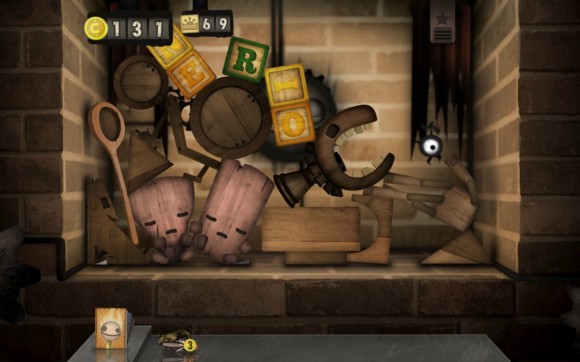
Little Inferno invites players to throw objects into a fireplace – the Little Inferno Entertainment Fireplace, to give it its grandiose 1950s catalogue-esque title – and set fire to them. You then watch them burn, which is a rather pleasant experience in itself, with the games visuals doing a neat job of evoking the pleasure of watching flames lick and flicker. Burning items gives you credits, which you can then spend on items from a catalogue to burn.
The core gameplay really is that simple. Burning items always returns a fraction more money than you invested, meaning that failure is impossible and progress inevitable – unless the player simply stops participating. While that option is no doubt strikingly obvious for some players when faced with a jingoistic, chauvinistic or simply moronic narrative, it’s one that is less likely to occur with a game that is presented in such a fundamentally charming fashion as Little Inferno. Besides, why would you not want to play?
The game does prove somewhat difficult as it bears on; burning items in particular combinations triggers ‘combos’ and identifying these is essential to unlocking new catalogues. There are ninety-nine of these combos in all, drawing on a pool of about one hundred and forty unique objects. My partner and I played through the entire game in a six hour straight; players approaching the game in smaller sessions or solo might derive greater longevity, though equally they might find the clues more obvious after a break to clear their heads.
The simplest example I can give is the very first combo, Bike Pirate, which involves burning a wooden bicycle and a toy pirate. Easy, right? Others are less obvious, relying on puns or references to visual clues that the player is trusted to recall. You’ll likely get there eventually.
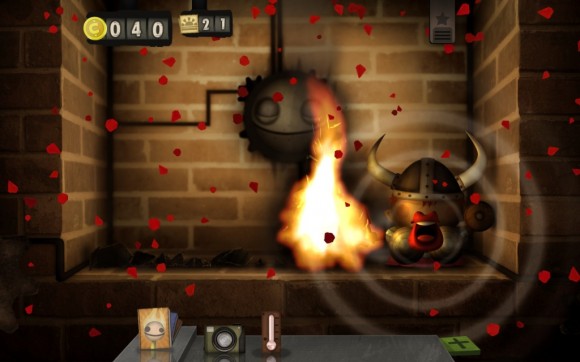
I’ll admit that my partner and I cheated and looked three combos up online, but only because we were pissed and really, really wanted to finish the game and order a pizza. We take our games criticism seriously here at Arcadian Towers, but we also take our booze and dinner seriously.
As with a game like McPixel (not reviewed on AR but thoroughly enjoyed here) the challenge lies less in challenge than in experience. It is, simply put, rather fun to burn objects that then behave in entertaining ways, and it is rather pleasing to figure out a clue and combine the correct set of objects in the fireplace.
It’s undeniable that some will find Little Inferno a game that doesn’t impose sufficient pressure on their dextruous or mental abilities and so find it unrewarding, but I’m not attempting to articulate that opinion. It’s also worth pointing out that while Little Inferno won’t draw upon your twitchy trigger fingers or ability to micromanage and multitask, it is a game that provides plenty to think on should you be prepared to engage. Certainly a part of that is the simple puzzle-solving of gameplay progression, but to a greater extent it lies in the deeper narrative and, dare I say it, subtext of the game.
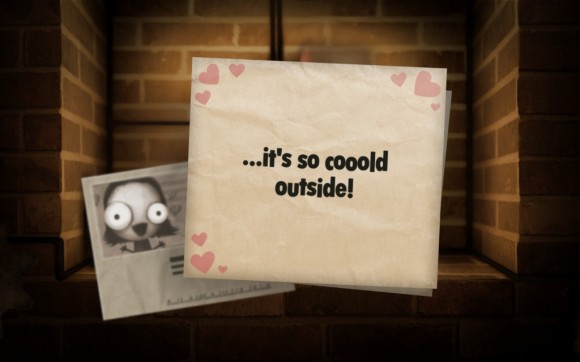
Can I make a brief diversion, just for a second? I feel I should note, before things get too serious, that the character and art design of this game is really something special. It all coalesces around a style I recognise as Gabler’s – anyone who’s played World of Goo will find plenty of familiar beats here – though Tomorrow Corp senior partner Kyle Gray also contributed significantly to the game’s art.
The music, too, is a marvelous assembly. There’s a real tonal mix present; the most out-of-place song is the one non-original piece on the soundtrack. It appears on the catalogue screen and was originally written for supermarkets in the 1950s. It’s a perfect fit for joyful, untroubled, unquestioning consumption: spend, buy, enjoy! Life is grand and nothing can go awry. The game’s original compositions are a varied bunch themselves, from advertising jingle ‘Little Inferno Just For Me’ evoking something similar to that madcap 50s tune through to more melancholic numbers such as ‘Reporting From the Weather Balloon’ or ‘Little Inferno Title’.
Music, as any fule kno, is an essential part of modern media when it comes to setting or supporting a tone. Little Inferno’s music is well-constructed in that it does not overtly attempt to evoke a feeling like the over-blown melodrama of a Disney or Michael Bay blockbuster, instead working to tug emotional reactions gently this way or that, subverting the generally joyous and playful tone of the gameplay. It is another suggestion that there is something else going on here that you should pay attention to.
And so we return to something a little more serious. At this point I should warn that we’re heading toward spoiler country. We’re not quite there yet but we’re certainly in the border territories, and so if you want to play Little Inferno and experience all of this for yourself before reading on, now’s the best time to stop.
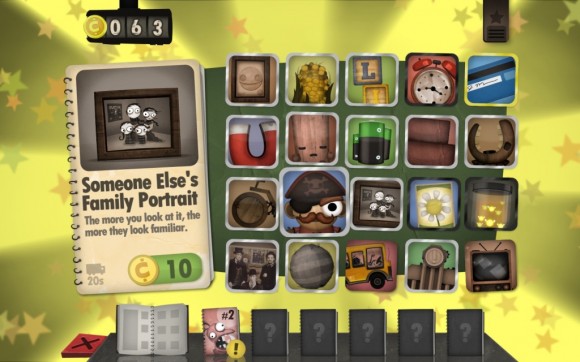
Still with us? Good. So I hinted above about the deeper narrative of Little Inferno; the story that extends beyond simply burning stuff and the subtext that invites us to think more critically than the game’s core mechanics overtly suggest.
Players receive messages as they progress through the game and these – like the soundtrack – are quite tonally diverse. Messages from the Tomorrow Corporation (itself an entity within the game, although headed by a cuddly-looking woman called Miss Nancy rather than a bunch of grinning male game devs) are congratulatory or celebratory, encouraging you to keep buying, burning and staring at the fire. Messages from your neighbour, a little girl called Sugar Plumps, are childlike and excitable, whilst updates from the Weatherman floating above the city are delivered with professional enthusiasm but grim in subject matter. The latter’s bulletins typically state that there is more snow on the way, which is little surprise as there is only ever snow, but there’s no need to worry so long as you stay warm in front of your fires.
“THIS CAN’T LAST FOREVER, HEH HEH!”
You can of course ignore all of the above if you wish, treating it as a simple distraction from the pyromaniacal tendencies that you wish to indulge, but it’s key to the game’s overall theme as well as being a rather well-paced method of breaking up the simple acts of buying and burning.
Now we’re heading into spoiler territory central, okay? This is your second warning and there is no third strike. This is no longer a review. It’s already clear that I think you should play this game, and if you’ve read this far you probably agree. From this point on it’s me having fun getting stuck into the game’s gory innards. This includes some endgame material.
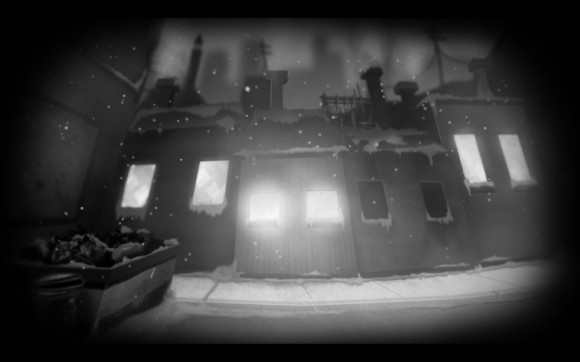
Throughout the game there are three main narrative threads. The first is driven by the weatherman, who is instrumental in contextualising the game’s more immediate worldbuilding. His sole job is to deliver weather updates from “above the smokestacks, above the city”. At points he makes references to chimneystacks stretching as far as the eye can see, the endless plumes of smoke, and of course the cold and snow. He’s a cheerful figure but the picture he paints is unavoidably a gloomy one of coldness and darkness and uniformity. His exhortations to stay in front of the brightness and warmth of the fire are fitting… and tempting. The world outside seems a scary place.
The second thread is held by Tomorrow Corporation matriarch Miss Nancy. I’ve already mentioned that her messages are full of encouragement to remain engaged with the Little Inferno Entertainment Fireplace and to keep watching the flames. At the very end of the game we learn a little more about her, but for the most part her role is to keep you locked in with enticement and praise.
The final narrative thread is woven by Sugar Plumps, your neighbour. Sugar Plumps begins as a very childlike figure, friendly towards you and full of warmth – no pun intended – for the Little Inferno Entertainment Fireplace. She delivers some sinister notes at times – her reference to the face in the fireplace watching you, in particular – but for most of the game she’s an enthusiastic and simple presence. This switches about halfway though when something goes awry and her house explodes, apparently killing her. The absence of Sugar Plumps’ cheerful letters is keenly felt, for a while.
Towards the end of the game you begin to receive letters from a mysterious source and it doesn’t take a genius to work out that this is Sugar Plumps. At this point in the game her messages are more shrouded but they soon become more clear, with lines such as “Little Inferno Entertainment Fireplace was designed to not matter”. She’s the character who most overtly passes commentary on the game’s themes.
These narrative strands represent, in turn, negative reinforcement, positive reinforcement, and the path of a fellow traveller between the two.
The world of Little Inferno – once you finally see more of it than the fireplace – is not a place characterised by power and force, but its hard not to recognise that the Weatherman encourages you to accept the status quo because the alternative is frightening whilst Miss Nancy encourages you to accept it because participation is joyful. Sugar Plumps, meanwhile, is ahead of you on an path that offers something else – something new, or perhaps something old and simply forgotten.
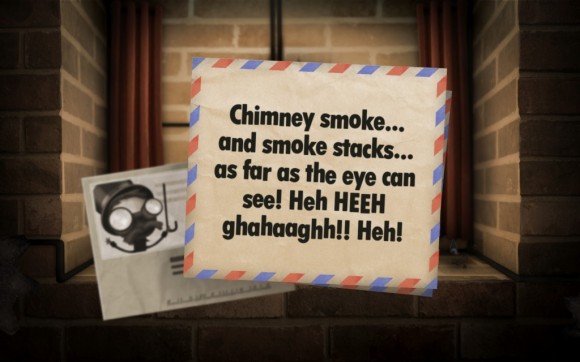
As I mentioned in the introduction the idea driving the initial development of Little Inferno was to “start with an exceptionally underwhelming premise, but then actually make the game really really surprisingly good”. Part of the latter involved, as Gabler went on to put it, “[being] taken on a ride, and not know[ing] where I’m going”.
In this sense my earlier comparison to McPixel is apt; player’s interactions with both games are very simple and often yield unpredictable immediate results. McPixel is significantly more off the wall and is designed to fox even the most lateral thinker – it doesn’t feature puzzles so much as it does a range of ridiculous scenarios that must all play out – and there is no grand narrative underpinning it, but that core idea of surprising and entertaining the player with the unexpected is a conceit that both games share.
The core of what Little Inferno concerns itself with is “games that don’t matter”: in particular it satirises common features of contemporary social and mobile games. This is sometimes simply done, as in the description for a combustible Gaming Tablet (“Filled with “free” games that will cost you thousands”), and sometimes integrated into its own gameplay; objects you order from the catalog involve cooldown timers which can be circumvented by using ‘stamps’. These will be familiar to anyone who’s played almost any Facebook game ever made and it’s often a kiss of death, though as it’s presented satirically here the timers are rarely very long and the stamps so common that running out of them is very unlikely.
But satire demands more than simple parodies, and these simple jibes and cuts aren’t more than that. So what else does Little Inferno have to say? Well, happily, the answer is potentially rather a lot – but the game is ambiguous and open enough to yield various interpretations. It’s for this reason that the game has lingered on in my mind so well.
That and Kitty Kitty Poo Poo, I mean.
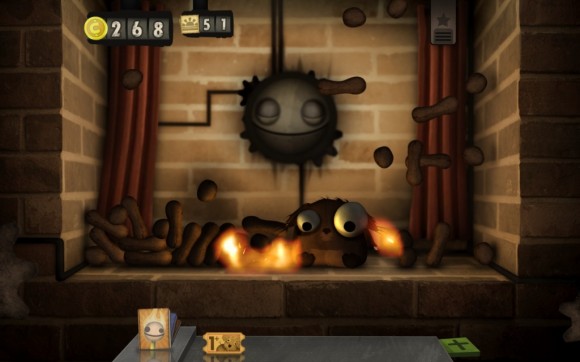
My own thoughts are that the Little Inferno Entertainment Fireplace, with its regular exhortations to not tear one’s gaze away from it, to not look behind you, and to not worry about the smoke and cold and world outside, is a clear reference to the tendency of players to focus on what’s in front of them and either disregard or fail to consider a game’s wider context. This could be socially broad, such as how that game relates to the cultures in which players or its developers are situated, or specific to the tenets of contemporary mobile and social game design which Little Inferno satirises. Either way the unquestioned purchasing of a variety of unique consumer goods which are literally thrown upon the fire as soon as you acquire them is a vivid metaphor. Sure, it’s also a central mechanic that must be engaged with to play the game, but it remains striking that the question ‘Why am I doing this?’ is rarely asked, let alone drawing broader comparisons.
As for the cold and darkness outside: well, there’s a suggestion at the end of the game – when the protagonist ultimately joins the Weatherman and soars above the clouds, or earlier when Sugar Plumps messages from the beach (or so she tells us) – that the darkness and smog is of our own making; our desire to stay indoors and eschew all of the experiences the world has to offer is a choice. In this sense the grim environment is similarly metaphoric.
It could also be read in a broader dystopic sense concerning climate change, in that the endless cycle of consumption and incineration has produced a ghastly world and one slowly dying world of endless smokestacks and closed-off environments. This is arguably supported by Miss Nancy departing the planet on a rocketship shortly after the protagonist wanders into her office, although she seems strangely full of excitement and hope for someone fleeing a dying planet.
This all takes place after she’s asked you what you will do now that you’ve left your house. Anyone could of course leave; they could look away from the fire. They could stop playing the game. They could walk away from the distracting cosiness of their Entertainment Product and go anywhere, do anything. It doesn’t matter what. It just matters that you make your choice. “DREAM BIGGER!!!” Miss Nancy proclaims, strangely enthusiastic that someone has opted not to engage with her products. It’s an inherently contradictory position that invites comparison to Tomorrow Corporation’s own intentions.
You can also read the main thrust of the game as being about growing up, about coming of age and stepping away from childish, meaningless things. It’s a valid reading, if a bit of a banal one, and I don’t think it’s accurate to suggest that it’s only children who gaze into the comforting warmth of meaningless acquisition and consumption.
Early on in the game I even wondered if the world was experiencing nuclear winter. “Nobody controls the weather”, Miss Nancy says. Well, perhaps.
Ultimately I feel Little Inferno‘s design is clever to make its central satire subtle through most of the game but unambiguous towards its end, to make its points without trying to trick the player or impress with its own cleverness, and to make its broader commentary open to a mix of interpretations by presenting it metaphorically through suggestion and implication. It’s perhaps a little sad that when it’s not subverting games and how we play them Little Inferno lacks bite, but an approach steeped in rhetoric could well have proven too dogmatic for a game that, ultimately, is mechanically and narratively concerned with satirising present day trends in game design. Besides, this ambiguity is what will help the game live on in the mind – much longer than a game about setting fire to amusing objects could be expected to.
I am undeniably excited to hear what your thoughts, interpretations and response to this game are. Please, join me in the comment threads below.
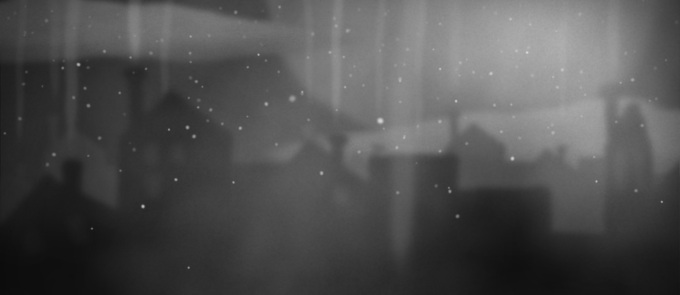
Comments
5 responses to “Little Inferno & games that do matter”
My whole family, me included, spent a good while on this delightful game. We like to burn things it seems, a lot.
Burning is a lot of fun… if nothing else Little Inferno wakes the pyromaniac inside us all. :)
I'm glad you loved it! I found Little Inferno to be a surprisingly beautiful and touching game. Works dealing with dependence on corporations are often extremely heavy-handed; any contact with The System is inherently corrupting because the system is inherently corrupt. The game makes it clear that playing with Little Inferno too much is either dangerous, or a distraction, but it's not evil–Miss Nancy seems sweet and doesn't have any nefarious agendas–and as long as it's played with within certain limits, it can be enriching. Engage with things to the point where they enrich your life, but once you've learned what you can, put aside childish things and move forward.
It's awesome this one has found an audience!
How is it that I write 3,000 words trying to meander towards a point and then you come along and sum it up in a single paragraph?
That said… I think what you've said there is a great point when you consider Little Inferno from an individual's perspective (and what are the narratives of games than the narratives of individualism and empowerment), but I'd say the game's world building suggests it is more pessimistic about its broader social context.
[…] safe to say I’m fairly sick of it. I’ve previously said that if I never see another cooldown timer as long as I live, it will not have been too soon. This clearly makes me the perfect person to try […]